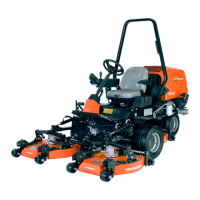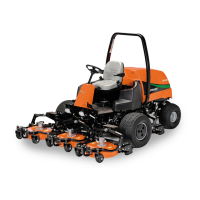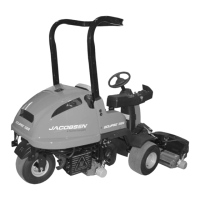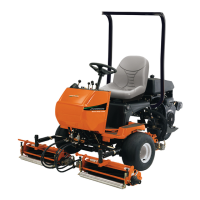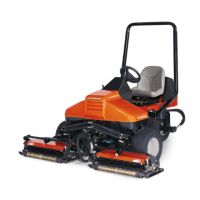en-66
11.2 Quality of Cut Troubleshooting
It is recommended that a “test cut” be performed to evaluate the mower’s performance before beginning repairs.
An area should be available where “test cuts” can be made. This area should provide known and consistent turf
conditions to allow accurate evaluation of the mower’s performance.
Another “test cut” should be performed after the completion of the repairs and/or adjustments to verify the
mower’s performance.
Before performing a “test cut” to diagnose cut appearance and mower performance, the following items should
be verified to ensure an accurate “test cut.”
1. Mowing (Ground) Speed
2. Blade Sharpness
3. Height-of-Cut (HOC)
4. Roller and Roller Bearing Condition
5. Blade Speed
11.2.1Washboarding
NOTE: Arrow indicates direction of travel.
Washboarding is a cyclical pattern of varying cutting
heights, resulting in a wave-like cut appearance. In
most cases, the wave tip-to-tip distance is
approximately 6—8 in. (15—20 cm). Color variation
(light-to-dark) may also be noticed.This condition is
usually caused by a rocking motion in the cutting
unit(s). This condition is found mostly on mowers
with multiple (suspended) cutting
units.Washboarding may also be caused by
variations in the turf.
Probable Cause Remedy
Mowing (ground) speed is too fast. Reduce mowing (ground) speed.
Grass build-up on roller. Clean the roller and scraper.
Roller is out of round. Replace roller.
Mowing in the same direction. Change mowing direction regularly.
Cutting units have too much or too little weight
on them.
Use weight transfer switch to transfer weight on or off cutting
units. (Refer to Parts & Maintenance Manual.)
Insufficient engine speed, not set to specifica-
tion.
Check/adjust engine speed. (Refer to Parts & Maintenance
Manual.)
Hydraulic system and/or rotary drive motor
performance is reduced.
Check hydraulic system performance (pump output, motor
operation, valve operation, relief valve settings, etc.).
11 PROBLEM SOLVING
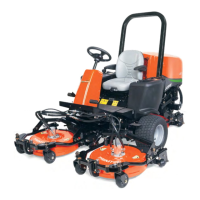
